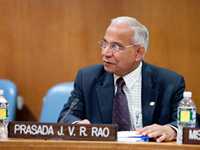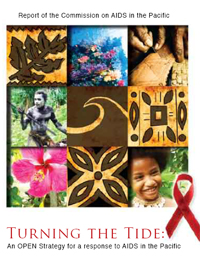Honourable Misa Telefoni Retzlaff, Chairman of the Commission on AIDS in the Pacific presents a commemorative gift to UN Secretary-General Ban Ki-moon to mark the launch of the report “Turning the Tide: An OPEN strategy for a response to AIDS in the Pacific”. New York, 2 December 2009.
Credit: UNAIDS/B. Hamilton
An independent Commission on AIDS in the Pacific recommends that HIV cannot be managed in isolation; it should be considered in the overall development context of the region. This is one of several recommendations stemming from the report that was launched today by UN Secretary-General Ban Ki-moon at the United Nations in New York.
Titled Turning the Tide: An OPEN strategy for a response to AIDS in the Pacific, the report outlines the key challenges that are blocking the AIDS response in the Pacific and presents decisive steps countries in the region should take to protect their societies, cultures and economies from HIV.
In addition, the report states that a “one size fits all” response does not suit the diversity of Pacific nations and outdated legislation criminalizing homosexuality and commercial sex is a major impediment in the region.
Governments, civil society and people living with HIV must come together to scale up the AIDS movement that is informed by evidence and grounded in human rights.
Michel Sidibé, UNAIDS Executive Director
"Punitive laws are a significant barrier to effective HIV prevention and our response to AIDS," said United Nations Secretary-General Ban Ki-moon. "We must uphold the rights of all people living with HIV. In particular, countries in the region must repeal laws that fuel stigma and discrimination against men who have sex with men, sex workers and injecting drug users."
Commenting on the report’s release, UNAIDS Executive Director Michel Sidibé said the Pacific region has a unique opportunity to achieve universal access to HIV prevention, treatment care and support, “Governments, civil society and people living with HIV must come together to scale up the AIDS movement that is informed by evidence and grounded in human rights,” said Mr Sidibé. “The AIDS response must become a catalyst to achieve the Millennium Development Goals in the region.”
Comprising some of the world’s smallest, most isolated and least developed countries, the Pacific region spans a third of the world’s surface and accounts for just 0.14% of the world’s population—with a similar proportion of the global burden of HIV. However, for Pacific countries, even a small number of people living with HIV can translate into high incidence and prevalence rates.

UNAIDS RST Director Prasada Rao addressed the launch of the report which was published by the Commission on AIDS in the Pacific. New York, 2 December 2009.
Credit: UNAIDS/B. Hamilton
Pacific countries are often included in broad Asia-Pacific regional groupings where the magnitude of the problem in Asian countries overshadows the challenges and needs of smaller Pacific countries.
These realities about the regions led to the constitution of an independent Commission on AIDS in the Pacific in October 2007 to examine the current scale of the HIV epidemic in the region.
HIV Incidence
Countries in the Pacific are at various levels of achieving the Millennium Development Goals, but the report claims it is unlikely that any will meet all the health targets by 2015.
There have been 29,629 reported cases of people living with HIV in the Pacific, with 5,162 new HIV diagnoses reported in 2008.
Papua New Guinea makes up the largest share of cases, growing exponentially from 21% in 1984–1989 to over 99% in 2008. Reported cases in Papua New Guinea total 28,294 but UNAIDS estimates there are 54,000 people living with HIV. It is estimated that by 2012, Papua New Guinea will have a national prevalence rate of 5.07% and a total of 208,714 people will have been infected with HIV.
The predominant means of HIV transmission in the region is unprotected sex. The number of HIV-positive young people is steadily increasing and young women are infected earlier than young men. New Caledonia, French Polynesia and Guam have identified unprotected male-to-male sex and injecting drug use as key drivers of their epidemics.
The Pacific Response

“Turning the Tide: An OPEN strategy for a response to AIDS in the Pacific”.
Between 2001 and 2009, funding for HIV programmes in the region increased more than five-fold to US $77 million in 2008. The cost of implementing HIV programmes in the Pacific is high due to cultural and linguistic diversity, limited and expensive transport networks, and poor communications infrastructure.
Although the Commission commended Pacific leaders for acting early to support an AIDS response, it also noted that knowledge is still limited because of poor surveillance and data collection and analysis.
The Pacific AIDS response will benefit more by focusing on unprotected sex and other high-risk behaviours, rather than population groups, it noted.
As strong family and faith-based ties are central to life in the Pacific, any hope for success addressing the epidemic depends on integrating responses to HIV within these social structures. The report also recommends that greater involvement of people living with HIV in matters of policy making and programme delivery will strengthen the response.
“AIDS in the Pacific should not be seen as a burden which is diverting resources away from other priorities,” said the Honourable Misa Telefoni Retzlaff, Chairman of the Commission on AIDS in the Pacific, who launched the report with the Secretary-General. “AIDS is an opportunity for development and for addressing the inequalities, inequities and injustices in our societies.”



 UNAIDS RST Director Prasada Rao addressed the launch of the report which was published by the Commission on AIDS in the Pacific. New York, 2 December 2009.
UNAIDS RST Director Prasada Rao addressed the launch of the report which was published by the Commission on AIDS in the Pacific. New York, 2 December 2009.  “Turning the Tide: An OPEN strategy for a response to AIDS in the Pacific”.
“Turning the Tide: An OPEN strategy for a response to AIDS in the Pacific”.